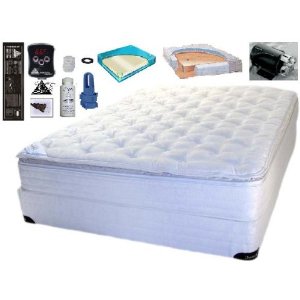In the beginning of the nineteenth century, Neil Amott, who was a Scottish physician, developed the first type of waterbed. His goal was to invent a bed that would possess the ability to prevent bedsores on people obliged to stay at home because of injuries, disabilities, or diseases.
For some unclear reasons, Dr. Arnott did not seek to obtain a patent for his creation, which allowed other inventors to copy it or develop their own.
Who Gets Credit For Inventing Waterbeds?
Charles Prior Hall was in 1968 credited with the invention of the modern waterbed.
Initially intending to develop an innovative chair, Charles Hall gave up on this project, after it turned out to be a failure, and focused on enhancing the bed.
Previous attempts to develop a waterbed mattress were attempted, but were not successful in the long term by the Goodyear rubber company many years earlier.
During his research, he received the support of his fellows SFSU Paul Heckel and Evan Fawkes. Charles Prior Hall managed to acquire a patent on his invention and named it the pleasure pit in 1971.
A few years later, he founded Innerspace Environments, a manufacturing and sales company that became the leading retailer of waterbeds in the United States. The company’s sales experienced a peak in 1987 in the domestic mattress industry of about 22 per cent.
Two Types Of WaterBeds
There are two types of waterbeds: softside waterbeds and hardside ones.
A softside waterbed mattress has the same appearance as a traditional mattress, but gives its users the opportunity to experience the sensation of lying on the water.
A softside waterbed can be used on a regular bed frame and with the same bedding items generally associated with regular mattresses. Owners of softside waterbeds, depending on their preferences, can choose to purchase shallow fill, mid-fill, or deep fill softside water beds.
A hardside water bed mattress is made of a pouch or bladder filled with water that is encased in a specially designed wooden structure. The frame of a hard side bed frame prevents the sides of the waterbed from bulging outward.
In order to operate, a hardside waterbed needs to have a heating element below its liquid component so that the water be maintained at a nice and warm temperature.
Advantages Of Waterbeds
Many advantages are associated with buying and using a waterbed: hardside waterbeds are affordable and last for long periods of time, while softside ones may be dressed with sheets of regular size or any other regular bedding item; waterbeds relieve all the pressure points of the human body, i.e. those of the neck, joint, and back so that the users do not have to worry about waking up in pain.
The mattress of a waterbed is effective against allergies if cleaned on a regular frequency, thus allergies triggered by allergens such as dust mites, mold, or mildew are all minimized; both softside and hardside waterbeds are efficient solutions against sleep disorders: this is because of the possibility they give to their owners to control the bed’s temperature depending on personal preferences; the acquisition of either a hardside or softside waterbed is a good deal given the quality of the items that come with the hardside waterbed and the adaptability that the softside one offers.
With waterbeds it is possible to eliminate motion and disruption in order to intensify the mattress support when sleeping; softside waterbeds are similar in physical appearance to regular mattresses; and the price of a waterbed is very affordable unlike what many potential customers might think.
At last the choice of buying a hardside or softside waterbed should be made based on people’s expectations and preferences. Both products can give a great deal of satisfaction to their owners and are not really cost-prohibitive. They were initially invented to serve for medical therapies but their usage has been broadened, which probably explains the success they have recorded.


